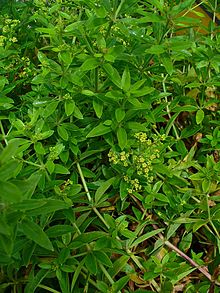1,8-dihydroxyanthraquinone
| Structural formula | ||||||||||||||||||||||
|---|---|---|---|---|---|---|---|---|---|---|---|---|---|---|---|---|---|---|---|---|---|---|

|
||||||||||||||||||||||
| General | ||||||||||||||||||||||
| Surname | 1,8-dihydroxyanthraquinone | |||||||||||||||||||||
| other names |
|
|||||||||||||||||||||
| Molecular formula | C 14 H 8 O 4 | |||||||||||||||||||||
| Brief description |
orange to brown powder |
|||||||||||||||||||||
| External identifiers / databases | ||||||||||||||||||||||
|
||||||||||||||||||||||
| Drug information | ||||||||||||||||||||||
| ATC code | ||||||||||||||||||||||
| properties | ||||||||||||||||||||||
| Molar mass | 240.21 g mol −1 | |||||||||||||||||||||
| Physical state |
firmly |
|||||||||||||||||||||
| Melting point |
190-193 ° C |
|||||||||||||||||||||
| solubility |
|
|||||||||||||||||||||
| safety instructions | ||||||||||||||||||||||
|
||||||||||||||||||||||
| Toxicological data | ||||||||||||||||||||||
| As far as possible and customary, SI units are used. Unless otherwise noted, the data given apply to standard conditions . | ||||||||||||||||||||||
1,8-Dihydroxyanthraquinone , also known as chrysazine or danthrone , is an organic compound from the group of anthraquinones (more precisely, the dihydroxyanthraquinones ).
Occurrence
Chrysazin comes in addition to other anthraquinones glycosidically bound in the roots of the dyers madder , and in many Aloearten (especially in real aloe ) as aloe-emodin before.
presentation
Chrysazine can be obtained by photooxidation of dithranol with stimulated oxygen. The following reaction mechanism was demonstrated using the oxygen isotope 18 O (shown in blue ).
properties
The 1,8-dihydroxyanthraquinone can be detected by mixing ether , magnesium sulfate and ammonia , because the ether phase and the aqueous phase turn red when present.
use
The derivatives and glycosides found in the aloe species have a laxative effect and are therefore used as laxatives.
Biological importance
Chrysazine is classified as a carcinogen in some countries. It does not act as a carcinogen , but only as an enhancer of cancer formation.
Individual evidence
- ↑ Danthron data sheet at AlfaAesar, accessed on July 24, 2017 ( PDF )(JavaScript required) .
- ↑ a b c d Entry on 1,8-dihydroxyanthraquinone in the GESTIS substance database of the IFA , accessed on January 22, 2018 (JavaScript required)
- ↑ Entry on Dantron. In: Römpp Online . Georg Thieme Verlag, accessed on June 21, 2018.
- ↑ a b Entry on 1,8-dihydroxyanthraquinone in the ChemIDplus database of the United States National Library of Medicine (NLM), accessed on July 13, 2017.
- ↑ Goverdina CH Derksen, Harm AG Niederländer, Teris A. van Beek: Analysis of anthraquinones in Rubia tinctorum L. by liquid chromatography coupled with diode-array UV and mass spectrometric detection. In: Journal of Chromatography A . 978 (1-2), 2002, pp. 119-127, doi: 10.1016 / S0021-9673 (02) 01412-7 .
- ↑ Berhanu M. Abegaz, BT Ngadjui, Merhatibeb Bezabih, LK Mdee: Novel natural products from marketed plants of eastern and southern Africa. In: Pure and Applied Chemistry . 71, 1999, doi: 10.1351 / pac199971060919 .
- ↑ Maher Kammoun, Sonia Miladi, Yassine Ali, Mohamed Damak, Youssef Gargouri, Sofiane Bezzine: In vitro study of the PLA2 inhibition and antioxidant activities of Aloe vera leaf skin extracts. In: Lipids in Health and Disease . 10, 2011, p. 30, doi: 10.1186 / 1476-511X-10-30 .
- ↑ Müller, K., Mayer, KK and Wiegrebe, Wolfgang: 1 O 2 -Oxidation of Dithranol to Chrysazine. In: Archives of Pharmacy . 319, 1986, pp. 1009-1018 urn : nbn: de: bvb: 355-epub-156619
- ↑ Wolfgang Schneider: About some analytically usable metal verifications (lithium, magnesium, aluminum) with the help of Istizin. In: Archives of Pharmacy . 283, 1950, pp. 248-253, doi: 10.1002 / ardp.19502830405 .
- ↑ Final community herbal monograph on Aloe barbadensis Miller and on Aloe (various species, mainly Aloe ferox Miller and its hybrids) (PDF; 109 kB) Committee on Herbal Medicines of the European Medicines Agency, October 26, 2006.
- ^ NTP Report on 1996 Background Document for Danthron Carcinogens. (PDF) Retrieved July 17, 2017 .



